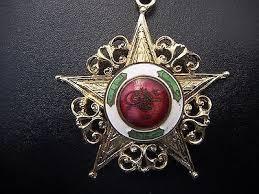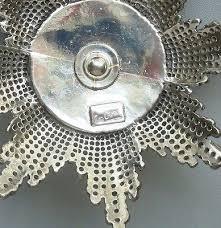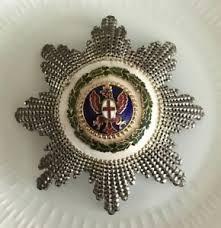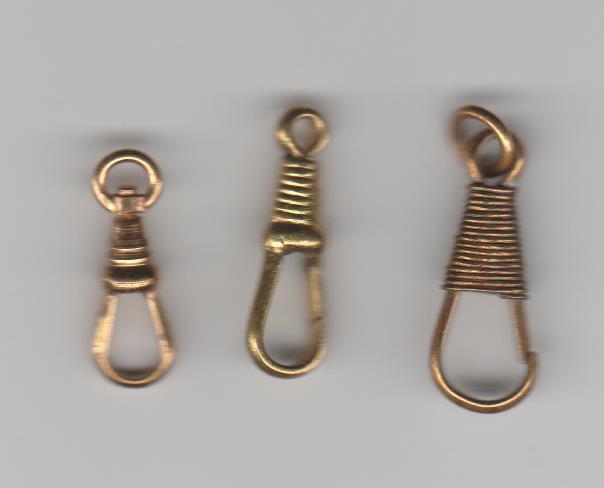
922F
-
Posts
1,382 -
Joined
-
Last visited
-
Days Won
7
Content Type
Profiles
Forums
Blogs
Gallery
Events
Store
Posts posted by 922F
-
-
-
Wonderful find Claudio! You undoubtedly are pleased, proud and very happy!
0 -
Vet society insignia? Cross & swords body component looks like inspired by or made using Bulgarian Military Bravery pin-back badge die . If latter probably 55 mm. diameter.
0 -
Hello Nick and thank you for this information, images and, most of all, for your good wishes! These images reveal high manufacture quality of a very rare 'modern' award. The document [to Martha Mödl the opera singer?] indicates the quality of persons honored with this decoration. All best regards, EJ
0 -
For general Information.
A colleague reminded me that the State of Bavaria renewed the Maximilian Order years ago and provided the following information. Insignia supposedly made by Hemmerle, Munich largely duplicates that of the 1853 Order save for the suspension.
Bavarian Maximilian Order
The Bavarian Maximilian Order for Science and the Arts is awarded in recognition of outstanding achievements in the fields of science and art and represents a particularly high state honor. The number of order holders should not exceed one hundred.
The award goes to German scientists and artists. The Order is awarded in a class to men and women. The ceremony takes place every two years. The Order is awarded by the Prime Minister. The Prime Minister is entitled to submit proposals, while the Ministers of State and the two departments of the Order are responsible for their areas of business.
The Bavarian Maximilian Order for Science and Art was created in 1980, following on from the original donated by King Maximilian II in 1853.
0 -
Emmanuel didn't Nelson Mandela receive the Order of Excellence of Guyana in 2006 or thereabouts?
0 -
Wonderful images!
0 -
Black enamel cross likely German Knight's Cross aka Randow Cross; silver cross probably a Russian exile St. George cross if centre is knight slaying dragon.
0 -
Tend to agree with P.F. Missing ones may mislead but this seems to be leaning towards one of his Red Cross oriented bars -- missing Hungarian Horthy-era Red Cross special decoration.
0 -
Thank you! I do not understand either but good photos!
0 -
Greetings Paul,
See thread below--this is first type and there was an associated collar.
0 -
Sold for about 1630 sterling or $2000 USD
0 -
Sometime ago a thread on Greek awards focused on the Greek Valor Cross--I cannot find that thread now, however. One point involved discussion of the very rare neck badge of this award. A GMIC member wanted to see examples of this award. Just yesterday, a French-made one sold at auction.
It realized about 4025 euros including commission. I do not seem able to post images but they now may be located at https://www.audap-associes.com/en/lot/99922/10897573
0 -
-
Bump seeking info on this anomaly
0 -
For nearly 40 years, the question of whether a royal Albanian langue of the Roman Catholic Order of the Knights of Malta ever existed during the Italo-Albanian Kingdom [1939-43] puzzled cognoscenti. Those interested will recall GMIC exchanges on this subject. [ See below, Bob's post of February 15, 2010]. Insignia purporting to be that of this order last appeared, to my knowledge, in a 1980's Graf Klenau auction catalog.
Now it appears that a slightly damaged collar and pin back badge identified as this insignia may be located and even purchased!!! Take a look at https://www.audap-associes.com/lot/99922/10897357. I do not know if free use provisions allow reproduction of the images so do not post them here.
WOWZA WOWZA
- Home
- European States
- Southern European & Balkan States
- Albania - Albanian threads index
0 -
Morton & Eden sold a Norwegian type several years ago, seem to recall that it was a dot behind enamel pattern variety. That image may be available directly from them or on-line. Don't remember seeing any 'sunray' examples within the past 20-30 years though Kai Meyer may have had one in the 1970's.
There are 2 types for Swedes, light blue enamel [and ribbon] and dark blue enamel [and ribbon]. The light blue [typical Swedish color] honored royals attending the celebration and dark blue went mainly to royal household staff. Neither of these have champlevé work under the enamel unlike the Norwegian variety.
Notes in the large Swedish book published in the 1950's provide the number of awards--sorry forgot the name of the book and author, it's in storage. There might be about 230 light and 260 dark examples issued.
0 -
Happy to help
0 -
Civil Division Order of Oman mini. See, among others, https://en.wikipedia.org/wiki/Order_of_Oman.
0 -
Elaborating on Rusty's above note, this image shows different Grand Cordon suspension swivel devices used by Messrs. Lattes/Bichay. Fahmy Bichay gave me these samples in 1980.
The first is a standard device [20 mm overall] which has a spring type closure. The metal loop swivels between the cone beneath the top ring and the 'washer’ at the top of the actual suspension loop. The cone is smooth save for a crimp line at the base. These are heavily gold plated and made in Germany pre-1939.
The second slightly larger standard device [25 mm overall] has a spring type closure but does not swivel. A series of rings appears on the cone. It is lighter weight and not as heavily gold plated, made in Germany or France after WW II.
The third 28 mm device illustrates those made by Bichay technicians. It is a brass color [and maybe metal] piece of shaped wire [round on the exposed side, flat on the inside] bent to the proper shape on a jig. It was then wrapped in thinner wire to simulate a cone with the added benefit of holding the 'correct' shape and provide additional spring tension for closure.
As to use, Fahmy told me that from about 1941-45 Anglo-Egyptian customs regulation defined commercially available closures as manufactured jewelry so they were 'non-essential' for the war effort. And they were 'enemy' sourced. The firm tried to secure these devices from the UK and U.S. but costs were excessive. So the company made the 3rd type 'in-house'. He thought that from 1947-56 2nd type swivels could be imported from Europe. The Suez affair and subsequent Egyptian tariffs disrupted supplies from about 1956-64. So again 'in house' swivels were used. About 1970, an Egyptian firm began making the 2nd type which Bichay used. Fahmy mentioned that some 3rd type without wire wrapping exist [somewhat similar to those used on current Polish sashes] but that those were not secure enough.
1 -
Chiefs of protocol generally work out of a nation's foreign ministry. For a Finnish example see https://fi.linkedin.com/in/matti-heimonen-6705082. Usually very senior diplomats, they oversee ceremonial occasion details such as the proper order of receiving lines, seating placements, the formalities of joint press conferences, the proper titles of foreign dignitaries, ensuring that those dignitaries' names are spelled correctly and supplying interpreters. They foster understanding between peoples and governments. As such they often receive awards in the course of international diplomatic and head of state exchanges.
Try the Greek Foreign Ministry website for Gregoriady leads.
0 -
2nd type, Red Robe so candidates include at least: pre WWI, Meyer or Scheid (Vienna), WW I & after Arthus Bertrand (Paris) and Huguenin (Le Locle). Sorlini and Griesbach & Knaus work is not often of this quality. But since there are no marks on ring (?) either of the Yugoslav makers might be possible. Some opine that Yugoslav makers did not make minis but retailed French or Swiss origin pieces.
Bertrand work often has a maker punch on ring, Huguenin not so much. Meyer and Scheid [pre WW I] minis usually have marks.
Lacking ring ID punches, sorry, but no definite answer from me! At least here are
0 -
Check OMSA ribbon bank--http://www.omsa.org/omsa-ribbon-bank/, If you are not an OMSA member you must join to access the ribbon bank.
0 -
Never saw fakes of this grade - crown enamels [at least] damaged
0





Andmen(r.)enlarge.jpg.c54dc92a7b9409cb9d3f39f01fa1ca19.jpg)

Who was with the Kaiser in Jerusalem in 1898?
in Germany: Imperial: The Orders, Decorations and Medals of The Imperial German States
Posted
In the mid-late 1970's, the rectory of the Church of the Redeemer in Jerusalem had a wall cabinet containing awards of former pastors and provosts in the provost's private reception room. It contained at least one Jerusalem Cross and several Olberg Crosses. These were not mounted in medal groups. Recall similar cabinets in the Armenian Patriarch's private formal dining room, one of which displayed an Olberg Cross.
No idea of provenance. Perhaps these were gifts from travelers and not awards to provosts [or the Patriarch] as they would not appear to be members of the official party. A donation to the Augusta Victoria Hospital Foundation may explain the Olberg Crosses.
What seemed to be a put-together bar [similar to 1980's Ohio type but without the 'hook' and good ribbons] with both a Jerusalem and an Olberg Cross appeared at a Greenbelt, MD, USA show maybe in '84. The bar included a Prussian Crown 3rd, an Ernestine knight lst, two or 3 German state civil medal, a Turkish Osmanie reduced size officer, and a Greek Redeemer. The Jerusalem Cross was in first place & the Olberg in second, which seemed odd. That one may still be out there.